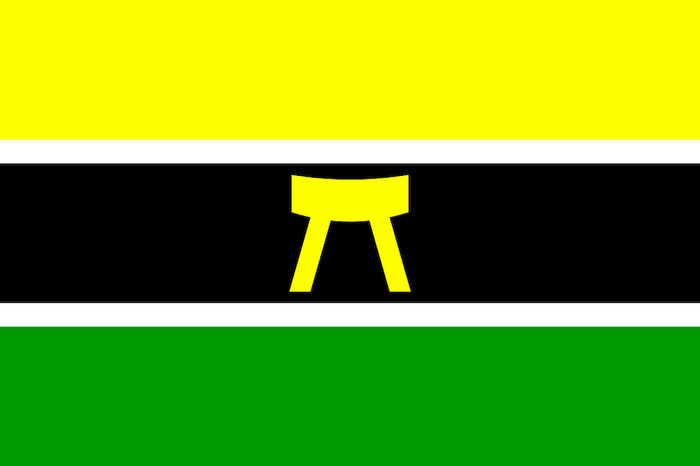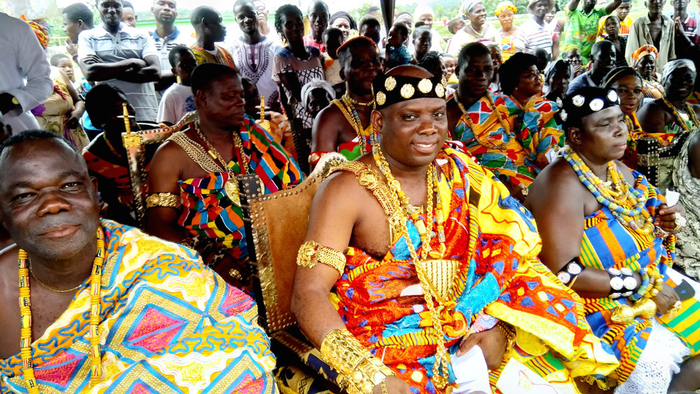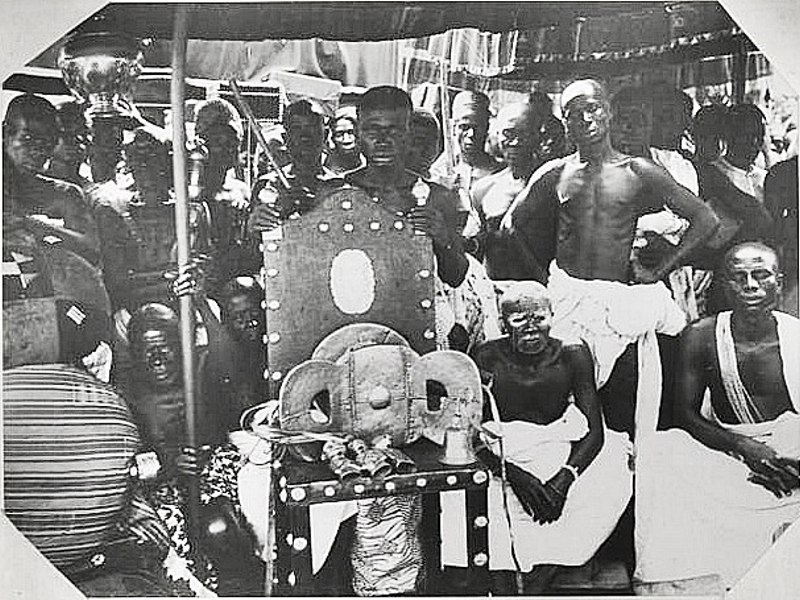Image: One of the very few photographs of the Golden Stool, 1937. Source: The National Archives UK via Wikimedia Commons
Throughout civilization, many nations have weaved the story of their history through various cultural objects, symbols, or monuments as an expression of their identity. In Egypt, the pyramids and the time of the Pharaohs speak about the history of the people, for the Mayans, it was their temples and remarkable writing system called glyphs, for the Ashanti people, it is the Ashanti Golden Stool.
To some, a stool is just a normal item they have in their homes but to the Ashanti people, the “Sika Dwa Koli” also referred to as the Ashanti Golden Stool is a symbol of their unity. For as far back as the Ashanti people can remember, many wars have been fought against native clans and colonizers in the quest to protect the stool and the identity of their people.
History
Since the 17th Century, the Ashanti stool has been a symbol of power and from which Kings not only ascended the throne but more importantly from where they received authority to rule over the people for it is believed that the stool embodies the spirits of the Ashanti people who have long passed on.
Based on oral history, it is said that Okomfo Anokye, a high priest and one of the founding fathers of the Ashanti nation called forth the stool from the heavens and caused it to land at the feet of Osei Tutu I who became the first Asantehene of the Ashanti Kingdom. From thereon, the seat has marked the ascendancy of each monarch.
A cultural people, the Ashanti operated a monarchical and spiritual style of governance wherein their leadership was selected based on the choice of the gods with the Golden Stool putting a seal on the rulership.
The Stool which is their most valuable object, is 18 inches in height, 12 inches in length, and 12 inches in width, and was made of solid gold with intricate designs and symbols. Due to the sacredness of the stool, it was never allowed to touch the ground and no one was allowed to sit on it. As part of the coronation process, the Ashanti King is lowered and raised over the Golden Stool without touching it. In the throne room of the Asantehene (which is the title of the reigning monarch), the Golden Stool occupies its throne next to the king.

The Ashanti Flag with the Golden Stool in its design. Public Domain
Golden Stool: Its Significance to the Ashanti People.
The Ashanti believed the stool to possess mystical powers that protect the Ashanti people. In the past, when the kingdom would go to war against neighboring kingdoms it was customary for the chiefs to consult with their ancestors and seek victory before the stool.
For each recorded victory over their rivals, and with the continued growth of the empire, the importance of the Stool became more revered. It was widely believed that as long as the stool was in the possession of the Ashanti people, their strength would be indisputable.
The reverence ascribed to this Stool caused an increased desire among many foreign powers who looked to conquer the Ashanti Kingdom and possess the Golden Stool.
By the 19th century, in an attempt to annex the Ashanti kingdom to the British Empire and seize the Stool, five conflict situations had already occurred between both Empires. Ultimately, the Ashanti Empire was finally conquered and incorporated into the British Gold Coast Colony which is the current Nation called Ghana.
The final conflict was a rebellious rise of the Ashanti people against the obnoxious demand by the then governor of the Gold Coast, Sir Fredrick Mitchell Hodgson, who had requested to sit on the Golden Stool.
Led by Yaa Asantewaa, who was the Queen Mother and keeper of the Golden Stool, the Ashanti people engaged in intense fighting with British Forces. The rebellion which was called the “War of the Golden Stool” is said to have led to the death of more than 3000 lives on both sides of the divide.
Though Yaa Asantewaa was captured and exiled by the British, the Stool was hidden by the Ashanti people and never captured by the British forces. This incident strengthened the representation and value of the Golden Stool to the Ashanti people and has become a reminder of their independence and strength.

Ashanti Chief at the Akwasidae festival in Kumasi, Ghana. Source: Wikimedia Commons
Today, Akwasidae Festival is celebrated as a way to honor the memory of their ancestors, recognize the achievements and feats of past Kings, reaffirm the heritage and indivisibility of the Ashanti people, and celebrate the importance of the Golden Stool. The festival is also used to remember the Battle of Feyiase which is also known as the Ashanti War of Independence
Over time, the Ashanti Golden Stool has exemplified the history, cultural identity, and traditions of the Ashanti kingdom. A dominant testament to the resilience of a people.

Okechukwu Nzeribe works with the Onitsha Chamber of Commerce, in Anambra State, Nigeria, and loves unveiling the richness of African cultures. nextquestservices@gmail.com





